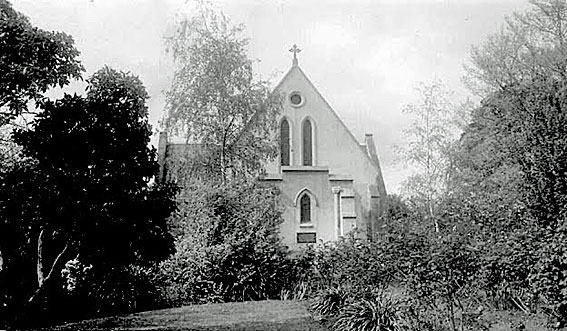
St James' Anglican Church, Dandenong
[photograph: Rose series postcard P13416 (after 1953)]

St James' Anglican Church, Dandenong
[photograph: Rose series postcard P13416 (after 1953)]
Historical and Technical Documentation by John Maidment
© OHTA 2020 (last updated February 2022)
The first church service in Dandenong was conducted on 21 July 1850 in Dunbar's Hotel, which also served as a court house and general venue for other purposes. The first building erected on the St James' site was a brick schoolhouse on the corner of Wilson Street. The first service in this building was conducted in 1857.1
The foundation stone of the present church was laid on 5 July 1864 by the Governor of Victoria, Sir Charles Darling.2 The opening and dedication by Charles Perry, Bishop of Melbourne, took place on 2 January 1865.3 Built in the English Gothic style, only the nave was initially erected. The architect was Leonard Terry and the builders Young & Foster. There were extensions in 1886, and a porch was added in 1953 to commemorate the men and women who served in the Second World War.4
First organ
The first pipe organ, installed in 1916, was of mid-19th-century English manufacture, comprising 1 manual and 5 speaking stops. It had been located at the Beechworth Town Hall between 1886 and 1908. It was removed in 1931 to St Alban's Anglican Church, North Melbourne, and returned in 2018 to the Beechworth Town Hall.
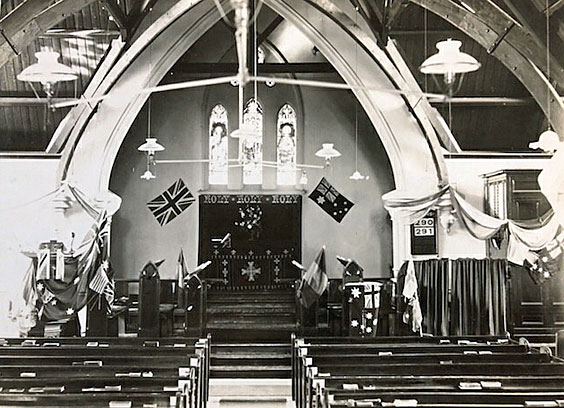
Interior of St James' Anglican Church, Dandenong showing the first organ on the right
[photograph from the St James' archives, courtesy of Jeremy Smith]
Present organ
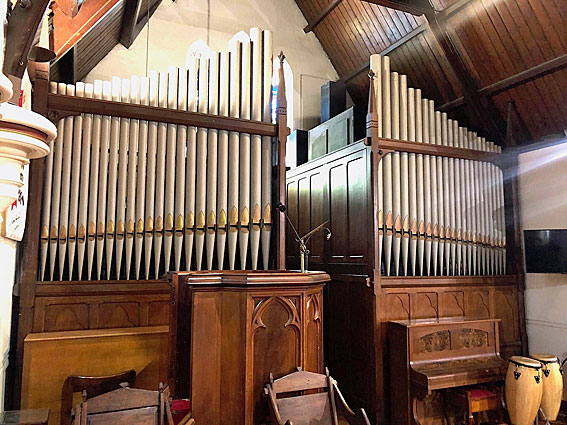
Case of the rebuilt Gray & Davison organ at Dandenong
[photograph by Jeremy Smith (June 2020)]
The present organ was built in 1867 by Gray & Davison of London, for St Patrick's Catholic Cathedral, Ballarat. The relevant entry in the firm's Shop Book follows:
10181
2 manuals CC to F Pedals 2 CCC-e
Swell throughout
| Doub.Diapason wood throughout Open Diapn metal Keraulophon " Tenor C grooved Stopd. Diapn wood Principal metal Fifteenth metal Mix 12.19.22 Oboe metal through Cornopean do do Clarion do do |
16 feet 8 " 8 " 8 " 4 " 2 " 3 rks 8 ft 8 " 4 " |
Pedal Organ
| Open Diapason wood Bourdon " Principal metal |
16 ft 16 " 8 " |
swell to have double sides & back filled in with sawdust and to open in two shutters not venetian
Great Organ
| Double Diapn wood through Open Diapn metal Dulciana " Viol di Gamba " Tenor C Stopd Diapn Bass & Clarionet Flute Prin Flute metal treble – wood bass 12th 15th Mixture Furniture [spare slide?] for Trumpet |
16 ft 8 " 8 " 8 " 8 " 4 " 4 " 4 ranks 2 ranks 8 ft |
Couplers
Great manual to Pedals
Swell manual to Pedals
Swell to Great manual
Six composition pedals 3 to Great 3 to Swell
Oak case
Glit or decorated pipes
Tuned to equal temperament
Date of order: 10 October 1866, placed with Dr Shiels, Balaarat
"For an organ of two manuals and pedals No 10,181 in oak cases with decorated pipes in Fronts, divided as to show window between, packed in stroing cases lined with zinc"
As per estimate 760
[total cost including freight and insurance] £792/7/6
The instrument was unusually divided on either side of a large window using mechanical action. At the time of its arrival, it was among the largest two-manual organs in Victoria, the only comparable examples being the 1853 Bevington & Sons organ at St Francis' Church, Lonsdale Street, Melbourne and the 1862 F.W. Nicholson organ at the Independent (Congregational) Church, Prahran. Its tonal design was almost identical to the acclaimed organ built by Gray & Davison for Llandaff Cathedral, in Wales, later moved to Usk (less the Choir Organ and pedal reed). The plan for the Ballarat organ was devised by Charles Thomas Plunket, formerly organist of St Francis Church, who was entrustred with the ordering of the instrument.
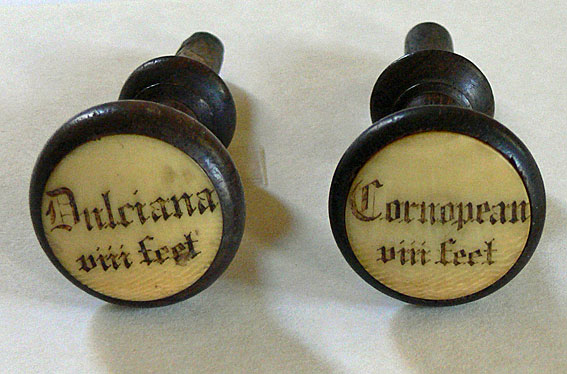
Two drawstops from the Gray & Davison organ – collection of John Henwood
[photograph by John Maidment (2010)]
The organ went on to suffer much rebuilding and alteration that has compromised its integrity as a Gray & Davison instrument:
In Ballarat, it was rebuilt in 1898 by George Fincham, who supplied a new console placed in the centre of the gallery (including new keyboards and pedalboard), remade the swell soundboard, extended the compass of the three pedal stops, supplied tubular-pneumatic action throughout, a hydraulic motor, added a Tenor C Clarionet to the Great, sub and super octave couplers, and tremulant.6
Electric blowing was installed in 1911, and the instrument was further rebuilt by George Fincham & Sons in 1931, when it was installed in its present location at Dandenong.7 It is uncertain whether the 1898 console was replaced at this time.
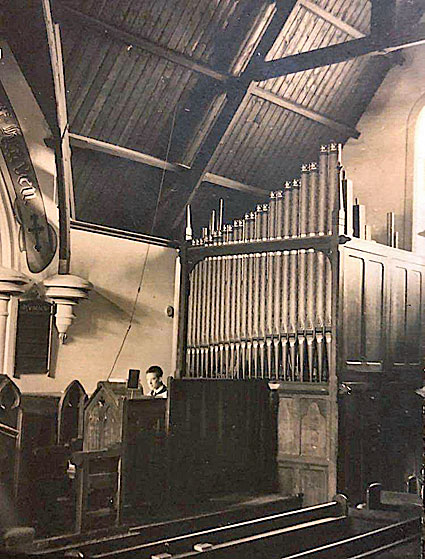
St James' Anglican Church, Dandenong –
left-hand side of the façade showing the stencilled pipes,
with Ernest Nye at the detached console
[St James' Church archives, courtesy of Jeremy Smith]
Full details of the organ appeared as follows in The Dandenong Journal when it was installed at St James':
ORGAN AT ST. JAMES
The organ which has been erected in St James' Church is now almost completed, and will prove to be a most important feature in Dandenong. In fact as a church and concert organ it has few superiors in this State. The instrument was originally built by Gray & Davidson [sic], in England, and has since been reconstructed on modern -lines by George Fincham & Sons Pty. Ltd. There are two manuals and pedal department; the great organ contains 11 stops, the swell organ 11 stops, and the pedal organ 3 stops; There are 5 couplers and all necessary accessories; such as combination pistons, crescendo pedals, etc. The action is tubular pneumatic throughout. The case work of English quartered oak is beautifully mellowed with age. The instrument is divided and placed each side of the South transept door, and the console, containing the keyboards, etc., placed on a platform so that the organist has complete command of the choir, with a full view of the nave and chancel.
A slight idea of the magnitude of the instrument and its many intricacies can be formed when we mention that three experts have been busily engaged for the past month fitting the various parts into position. Within a week the voicing of the pipes will be commenced, and the tone blended to the acoustics of the building.
A 2-horse power electric motor is necessary to generate the wind. This plant has been placed outside the church in a specially constructed brick and concrete chamber.
The complete specification is as follows:
Great Organ: Bourdon16 feet, 56 pipes; open diapason 8ft, 56 pipes; gamba 8ft, 56 pipes; dulciana 8ft, 56 pipes; clarionet flute 8ft, 56 pipes; principal 4ft, 56 pipes; flute 4ft, 56 pipes; twelfth 3ft, 56 pipes; fifteenth 2ft, 56 pipes; mixture 2 ranks,112 pipes; clarionet, 8ft, 56 pipes. Swell Organ: Bourdon 16ft, 56 pipes; open diapason 8ft, 56 pipes; stopped diapason 8ft, 56 pipes; gamba 8ft, 44 pipes; principal 4ft, 56 pipes; piccolo 2ft, 56 pipes; mixture 3 ranks,168 pipes; cornopean 8ft, 56 pipes; oboe, 8ft, 56 pipes.; clarion 4ft, 56 pipes, tremulant. Pedal Organ: Open diapason 16ft, 30 pipes; bourdon 16ft, 30 pipes; principal 8ft, 30 pipes. The total number of pipes in the instrument is 1422. Couplers: Swell to great sub octave, swell to great super octave, swell to great unison, great to pedals, swell to pedals. When the organ is completed and opened at the end of the month a great musical treat is assured; a recital by a prominent Melbourne organist is being arranged, and full particulars of this will be published shortly. ' . It would not be possible to extend too great a praise to George Fincham and Sons for their faithfulness in executing this work, which is so great that one would require to see it in progress before realising its enormity.8
The opening in Dandenong did not proceed without incident:
MUSIC AT ST. JAMES'
Services, on Sunday, at St. James' church were rendered additionally attractive by virtue of the playing of the new pipe organ. At the keyboard sat Mr. Falmar, assistant organist at St. Paul's, Melbourne, who gave at the close of each service a recital which was intensely appreciated. lt is possible that gentleman will return to Dandenong at a later date, when he will give a recital. So sincere are people in their desire to aid the organ fund one contributor of a loan of £l00 has now kindly offered to donate that sum outright. Others have been generous in other directions, and money for the organ has been coming in regularly. Writing of the recent opening service, the Dean of Melbourne declared: "How wonderfully the people of Dandenong sang. The organ perhaps was opened a few days too soon. I hope, however, that the ciphering of two pipes on two occasions during Dr Floyd's recital was not unduly disturbing while it lasted. It certainly was a memorable occasion".9
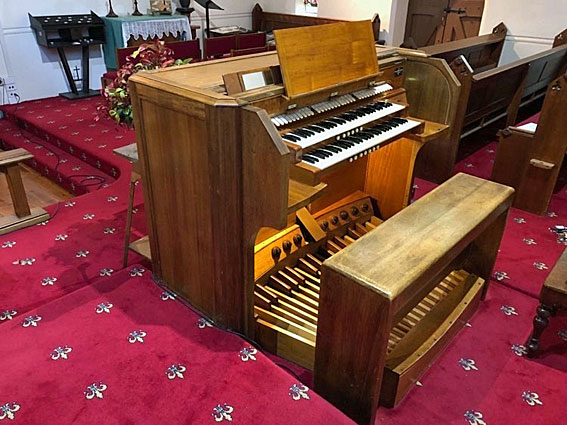
St James' Anglican Church, Dandenong: 1961 organ console
[photograph by Jeremy Smith (June 2020)]
Since being installed in Dandenong, the organ was has undergone further alteration. The stencilling of the façade pipes has been overpainted in silver. It was rebuilt in 1961 by Hill, Norman & Beard (Australia) Pty Ltd (o/n V494),10 who removed a number of Gray & Davison ranks and left the slides that they occupied vacant, in a quest to make the tonal scheme more neo-classical. Sir William McKie, Director of Music at Westminster Abbey, gave a recital shortly afterwards.
Further alterations were made in 1979 by R.J. Heatley, who added a partially new great Mixture IV, and a new swell Trumpet and Mixture. A swell Vox Angelica 8 was added in 1992 by Australian Pipe Organs.11 The 1898 Clarionet, renamed Krummhorn, was removed and sold to Holy Trinity Church, Williamstown.
In recent years, the organist of the church, Jeremy Smith, who is also a professional organbuilder, has carried out the following changes with the emphasis on recreating the original Gray & Davison style of the instrument:
• The Swell Oboe has been transposed back to 8ft pitch
• The Great Flute 4ft has had the Hill, Norman & Beard canistered cut down Dulciana pipes replaced with a period open wooden Flute from middle C upwards, in memory of Bishop Barbara Darling
• Replacement of the Great Dulciana 8ft and Viol di Gamba 8ft (Bell Gamba) with period black metal pipes is yet to take place
• Provision of a new Great Trumpet in place of the existing Clarinet (Krummhorn)
Only around half of the original Gray & Davison pipework has therefore survived.
The current specification, which comprises 25 speaking stops and 9 couplers, is:
| GREAT ORGAN Lieblich Bourdon Open Diapason Rohr Gedeckt Octave Flute Nasat Superoctave Mixture Trumpet |
16 8 8 4 4 2-2/3 2 IV 8 |
G&D Swell Bourdon A G&D G&D Clarionet Flute G&D 1-12 G&D and open wood Flute mid C up Jeremy Smith G&D Twelfth G&D Fifteenth 2 rks G&D and 2 rks R.J. Heatley 1979 Walker 1954, ex St Francis Xavier’s Cathedral, Adelaide, inserted 2022 Jeremy Smith in place of former Krummhorn 8 |
|
| SWELL ORGAN Open Diapason Stopped Diapason Salicional Vox Angelica Principal Octave Mixture Trumpet Oboe Tremulant |
8 8 8 8 4 2 III 8 8 |
G&D G&D G&D Keraulophon TC, Australian Pipe Organs 1992 G&D G&D Fifteenth R.J. Heatley 1979 (new) R.J. Heatley 1979 (new: Rogers pipework, harmonic trebles) G&D (transposed to 16 HN&B retd to 8ft Jeremy Smith) |
|
| PEDAL ORGAN Majorbass Subbass Lieblich Principal Flute Quint Octave Flute |
16 16 16 8 8 5-1/3 4 |
G&D Open Diapason G&D Bourdon Bourdon 16 A G&D A A A |
|
| COUPLERS Swell to Great Swell Sub Octave to Great Swell Octave to Great Swell Sub Octave Swell Unison Off Swell Octave Swell to Pedal Swell Octave to Pedal Great to Pedal |
Electro-pneumatic action
Compass: 61/30 (manual windchests 56 notes)
Balanced swell pedal
5 thumb pistons to Great
5 thumb pistons to Swell
5 toe pistons to Pedal
Reversible thumb pistons for:
Great to Pedal
Swell to Pedal
Swell to Great
Reversible toe pistons for:
Great to Pedal
Swell to Pedal
Swell to Great
Great and Pedal pistons coupled
Swell and Pedal pistons coupled
Divisional cancellation bars.
Sprung regulators
Detached stopkey console12
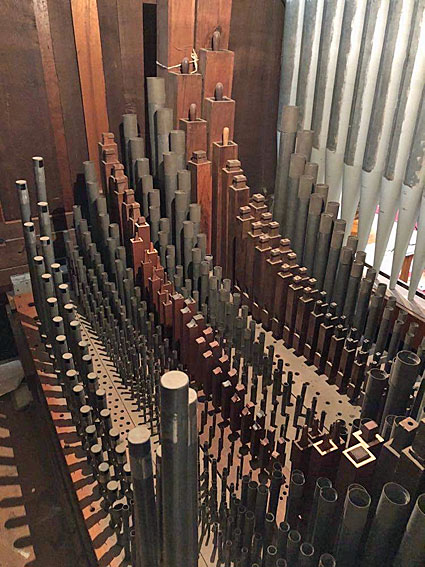
St James' Anglican Church, Dandenong: Great pipework
[photograph by Jeremy Smith (June 2020)]
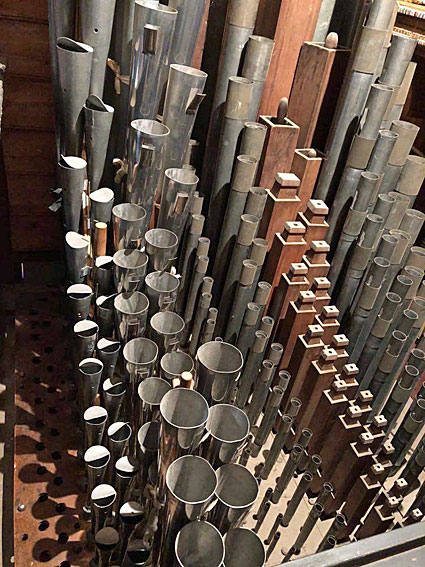
St James' Anglican Church, Dandenong: Swell pipework
[photograph by Jeremy Smith (June 2020)]
1 https://www.stjamesdandenong.com/history – accessed 19 May 2020.
2 The Herald (6 July 1864), p. 3; South Bourke Standard (8 July 1864), p. 2.
3 The Argus (29 December 1864), p. 7.
4 https://www.weekendnotes.com/open-house-melbourne-dandenong – accessed 19 May 2020.
5 Gray & Davison Shop Books (British Organ Archive), order 10181.
6 George Fincham Letters, 10/499, 15/305 and Fincham Papers (list), cited in Enid Matthews, Colonial Organs and Organbuilders (Carlton: Melbourne University Press, 1969), p. 161.
7 George Fincham Papers (list), cited in Enid Matthews, op. cit., p. 161.
8 The Dandenong Journal (22 January 1931), p. 5.
9 The Dandenong Journal (12 February 1931), p. 4.
10 OHTA News, vol. 10, No. 1 (January1986 ), pp. 16-17.
11 Personal Communications to John Maidment from Robert Heatley, 1979 and 1992.
12 Specification noted 1966 by John Maidment; annotations by Jeremy Smith, 2020.